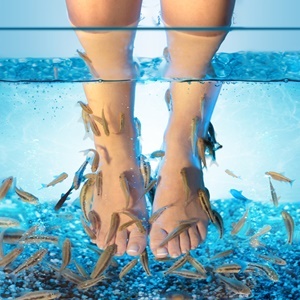
A New York City woman who got a trendy "fish pedicure" may have lost a little more than the dead skin on her feet – she may also have lost her toenails.
During a fish pedicure, people immerse their feet in warm water and let "doctor fish" (Garra rufa) eat away at dead skin. The procedures have become all the rage in recent years.
Price of beauty
A dermatologist who treated the woman says the tiny doctor fish that feasted on the 20-something's feet somehow triggered onychomadesis – a condition involving "a complete halt in nail plate production".
"Being omnivores," the fish "will eat human skin," wrote case report author Dr Shari Lipner, a dermatologist at Weill Cornell Medicine in New York City.
In fact, one clinical trial found that doctor fish were a useful treatment for people with psoriasis – the fish ate away psoriatic skin but left healthier bits untouched, Dr Lipner said in the report.
However, routine use of the fish for pedicures is another matter, she said, and may often cause more harm than good.
The case report was published in the journal JAMA Dermatology.
Cause for concern
"First, tubs and fish cannot be adequately sanitized between people," Dr Lipner said, "with the same fish typically reused for several persons."
That raises the odds for infections transmitted between customers, and "several bacteria capable of causing disease in humans were isolated in batches of Garra rufa and waters from 24 fish spas," she said.
There have even been two recorded cases of serious staph infections tied to fish pedicures, Dr Lipner noted.
"Therefore, their use has been banned in at least 10 states in the United States," she said.
While fish pedicures are available in South Africa, in 2012 the National Council of SPCAs wrote a letter to the Department of Health raising their concern about these pedicures. The NSPCA were concerned not only for the harm these pedicures may cause for the fish but also the potential health risks for the people involved.
In the new case report, the young woman complained of six months of abnormal toenail growth. Despite being in good health with no prior history of nail disorders, some of her toenails showed a separation and gradual disappearance of the underlying nail bed.
Getting nature involved
Dr Lipner diagnosed onychomadesis – a not-uncommon condition that's most often linked to underlying major illness or certain medications. Ruling those causes out, "to my knowledge this is the first case of onychomadesis associated with a fish pedicure," she said.
Just how the nibbling fish triggered onychomadesis "is unknown," Dr Lipner said, but "it is likely that direct trauma caused by fish biting multiple nail units causes a cessation in nail plate production."
One skin expert not involved with the case said the report raises cause for concern.
"Chalk this one up to 'not everything natural is good for you'," said Dr Doris Day, a dermatologist at Lenox Hill Hospital in New York City.
"Unfortunately the water is sometimes contaminated with bacteria and other pathogens and the fish themselves can do more damage than good," Dr Day said.
Image credit: iStock




 Publications
Publications
 Partners
Partners










